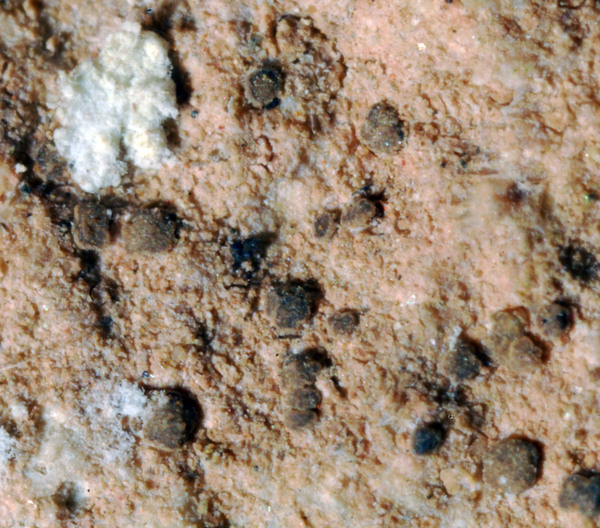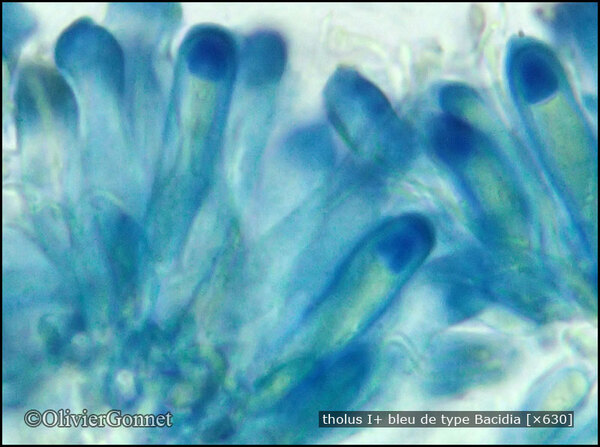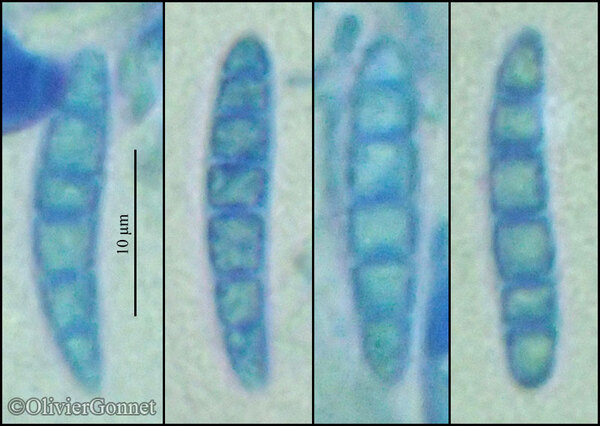Scutula effusa (Rabenh.) Kistenich, Timdal, Bendiksby & S.Ekman
Taxon, 67: 896, 2018.. Basionym: Bilimbia effusa Rabenh. - Lich. Eur. Exs.: No. 32, 1855.
Synonyms: Bacidia auerswaldii (Stizenb.) Mig.; Bacidia effusa (Rabenh.) Lettau; Bacidia effusella Zahlbr.; Lecidea auerswaldii Stizenb.; Lecidea effusa (Rabenh.) Stizenb.
Distribution: S - Cal (Puntillo 1996).
Description: Thallus crustose, thinly episubstratic, consisting of (36-)60-80(-145) μm wide, dispersed to contiguous, subglobose or slightly flattened granules, pale grey, pale yellowish grey, pale green to brown-green; prothallus sometimes present between granules, pale grey, mostly endosubstratic. Apothecia lecideine, (0.3-)0.4-0.6(-1.1) mm across, with a flat to slightly convex, epruinose, orange-brown to red-brown, finally sometimes almost black disc and a persistent, raised, smooth proper margin which is concolorous with or slightly darker than disc in upper part, distinctly paler, pale pink to orange-brown in lower part. Proper exciple 45-75 μm wide laterally, without crystals, the outer part orange to red-brown (sometimes black-brown in upper part), becoming gradually colourless downwards, the margin with a single layer of enlarged cells; medullary part colourless; epithecium orange-brown to black-brown, at least partly K+ purplish and N+ orange-red; hymenium colourless, (74-)80-110(-114) μm high; paraphyses 1-1.7 μm thick at mid-level, the apical cells clavate, (1.6-)2.6-3.2(-5.7) μm wide; hypothecium colourless or very pale yellow. Asci 8-spored, with an amyloid tholus, a diffuse non-amyloid apical cushion, and an outer amyloid wall layer. Ascospores (3-)5-7(-9)-septate, hyaline, fusiform with blunt ends, straight, not coiled in ascus, (19-)23-28(-33) x (4-)5-6(-7.5) μm. Photobiont chlorococcoid. Spot tests: thallus K-, KC-, C-, P-. Chemistry: thallus without lichens substances; apothecia with the Laurocerasi-brown and Rubella-orange pigments (the latter usually in traces).Note: a mild-temperate to humid subtropical, mainly subatlantic species of humid, open deciduous forests, also known from France and the Austrian Alps. It is included in the Italian red list of epiphytic lichens as “Critically Endangered” (Nascimbene & al. 2013c).
Growth form: Crustose
Substrata: bark
Photobiont: green algae other than Trentepohlia
Reproductive strategy: mainly sexual
Most common in areas with a humid-warm climate (e.g. most of Tyrrenian Italy)
Commonnes-rarity: (info)
Alpine belt: absent
Subalpine belt: absent
Oromediterranean belt: absent
Montane belt: extremely rare
Submediterranean belt: absent
Padanian area: absent
Humid submediterranean belt: extremely rare
Humid mediterranean belt: absent
Dry mediterranean belt: absent

Predictive model
Herbarium samples
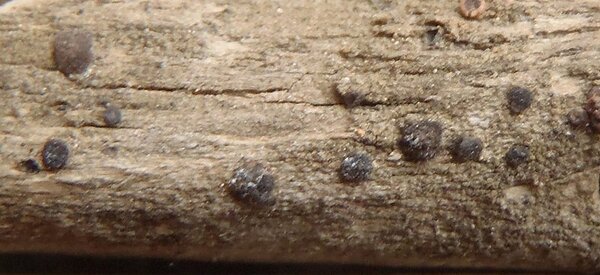

Curtis Randall Björk – CC BY-SA 4.0
Idaho, Shoshone County, Coeur d'Alene Basin Photographed from specimen (Björk 9300, UBC), lignicolous on Pinus monticola twig in rainforest May, 2004

Courtesy Danièle et Olivier Gonnet - Source: https://www.afl-lichenologie.fr/Photos_AFL/Photos_AFL_S/Text_S3/Scutula_effusa.htm
France, 10/10/2017 - Corse - (20) - Capu di Muru, sentier tour de capu di Muru, alt. 15 m, sur Juniperus phoeniceae
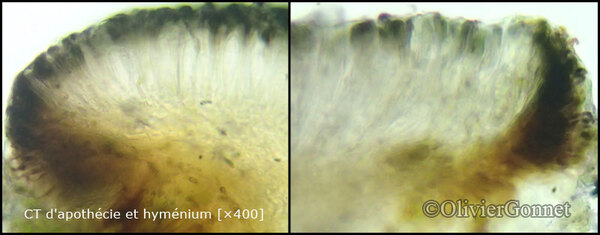
Courtesy Danièle et Olivier Gonnet - Source: https://www.afl-lichenologie.fr/Photos_AFL/Photos_AFL_S/Text_S3/Scutula_effusa.htm
France, 10/10/2017 - Corse - (20) - Capu di Muru, sentier tour de capu di Muru, alt. 15 m, sur Juniperus phoeniceae

Courtesy Danièle et Olivier Gonnet - Source: https://www.afl-lichenologie.fr/Photos_AFL/Photos_AFL_S/Text_S3/Scutula_effusa.htm
France, 10/10/2017 - Corse - (20) - Capu di Muru, sentier tour de capu di Muru, alt. 15 m, sur Juniperus phoeniceae
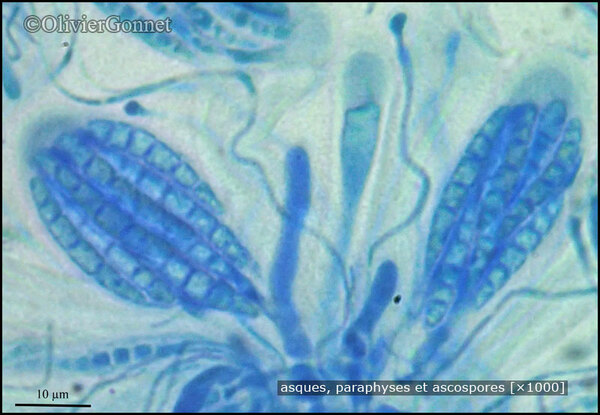
Courtesy Danièle et Olivier Gonnet - Source: https://www.afl-lichenologie.fr/Photos_AFL/Photos_AFL_S/Text_S3/Scutula_effusa.htm
France, 10/10/2017 - Corse - (20) - Capu di Muru, sentier tour de capu di Muru, alt. 15 m, sur Juniperus phoeniceae
Growth form: Crustose
Substrata: bark
Photobiont: green algae other than Trentepohlia
Reproductive strategy: mainly sexual
Most common in areas with a humid-warm climate (e.g. most of Tyrrenian Italy)
Commonnes-rarity: (info)
Alpine belt: absent
Subalpine belt: absent
Oromediterranean belt: absent
Montane belt: extremely rare
Submediterranean belt: absent
Padanian area: absent
Humid submediterranean belt: extremely rare
Humid mediterranean belt: absent
Dry mediterranean belt: absent

Predictive model
| Herbarium samples |


Curtis Randall Björk – CC BY-SA 4.0
Idaho, Shoshone County, Coeur d'Alene Basin Photographed from specimen (Björk 9300, UBC), lignicolous on Pinus monticola twig in rainforest May, 2004

Courtesy Danièle et Olivier Gonnet - Source: https://www.afl-lichenologie.fr/Photos_AFL/Photos_AFL_S/Text_S3/Scutula_effusa.htm
France, 10/10/2017 - Corse - (20) - Capu di Muru, sentier tour de capu di Muru, alt. 15 m, sur Juniperus phoeniceae

Courtesy Danièle et Olivier Gonnet - Source: https://www.afl-lichenologie.fr/Photos_AFL/Photos_AFL_S/Text_S3/Scutula_effusa.htm
France, 10/10/2017 - Corse - (20) - Capu di Muru, sentier tour de capu di Muru, alt. 15 m, sur Juniperus phoeniceae

Courtesy Danièle et Olivier Gonnet - Source: https://www.afl-lichenologie.fr/Photos_AFL/Photos_AFL_S/Text_S3/Scutula_effusa.htm
France, 10/10/2017 - Corse - (20) - Capu di Muru, sentier tour de capu di Muru, alt. 15 m, sur Juniperus phoeniceae

 INDEX FUNGORUM
INDEX FUNGORUM
 GBIF
GBIF
